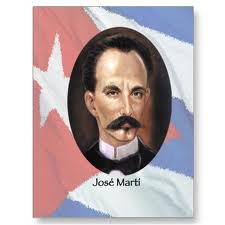
By Julio Cesar Galvez
The figure of José Martí has been used in an unmeasured way for their search for political prominence by the Cuban regime, long before the seizure of power on January 1959.
Many young people are unaware of the truth about the man who fell in Dos Rios fighting against Spanish colonialism. He has been co-opted by the educational system imposed on the island for more than half a century, which has twisted history at will. But many Cubans, scattered throughout the world, remember this figure, the thinking and actions of José Martí, not only on the 160th anniversary of his birth, but every single day of the year.
Undoubtedly, and without any chauvinism, Martí can be classified as a person of exceptional qualities within the group of nineteenth century men of ideas and thinking throughout the Americas.
I will not attempt to recount, much less make a personal comparison between Martí and José de San Martín, the valiant warrior who ceded the glory to Simon Bolivar, in Peru; the Mexican priest Miguel Hidalgo, who was magnanimous to his defeated opponents; Sucre, the betrayed and murdered Mariscal de Ayacucho; or the Indian Benito Juárez, El Benemérito de las Américas, who furthered the ideals of Father Hidalgo, who went in his carriage to defeat the invading French, when he said: “The people and the government should respect the rights of all. Among individuals, as among nations, respect for the rights of others is peace. ” They all were and are great Americans.
From a very young age he became interested in reading. Inhis imagination he traveled with thinking of the classics of Greece and Rome to the most ancient East. Drank as from the national fountains of the priest José Agustín Caballero, of José Antonio Saco, Domingo del Monte and Father Felix Varela. He recognized the work of Gertrudis Gómez de Avellaneda and internal struggle of the misunderstood exil José María Heredia, the “Cantor del Niágara.”
He castigated Carlos Manuel de Cespedes and Ignacio Agramonte for disagreements, what’s more he understood that with them predominated zeal for the best performance of duty to the Fatherland. He praised Constituent Assembly of Guámiro, which he considered the birth of the democratic future of the Cuban people.
He loved beauty, life, flowers, women, children, poetry, his neighbor, the freedom and independence of his homeland … but was also misunderstood.
José Martí still remains a misunderstood figure for most Cubans. The infinite legacy he left is in his voluminous correspondence sustained through the years with family, friends, writers and literati, personalities of his era and independence fighters; in his speeches, in his newspaper articles; in his reinvented, multifaceted complex poetry and his tremendous work as a revolutionary fighter.
His oratory, his power of persuasion, passion and personal commitment to provide the basis and foundation of the Cuban Revolutionary Party, and his hard work on the unification of the Cubans, rising above differences and opinions found between independence fighters prior to the “necessary war” to achieve independence from Spain, are still themes that are studied today.
He was a prophet or a predestined, perhaps ahead of his times. He always lived with the worry of finding solutions to the complex problems of his beloved Cuba. In many ways he lived an adverse life. A third of his life was spent outside the island. Spain, Britain, Mexico, Guatemala, Venezuela, Jamaica and the United States formed the corollary of his extensive experience as a political exile.
Now, 160 years since the birth of the Apostle, his dream of a Cuba, “With all and for the good of all,” is unrealized. Used as propaganda standard for the personal ends of the dictators for more than 50 years, Cuba is far from the example of civility and morality I was always taught since I was a little boy in school.
Those who recall his birth every January 28 are aware that Jose Marti still has much to teach and do for the future of Cuba.
January 28 2013
